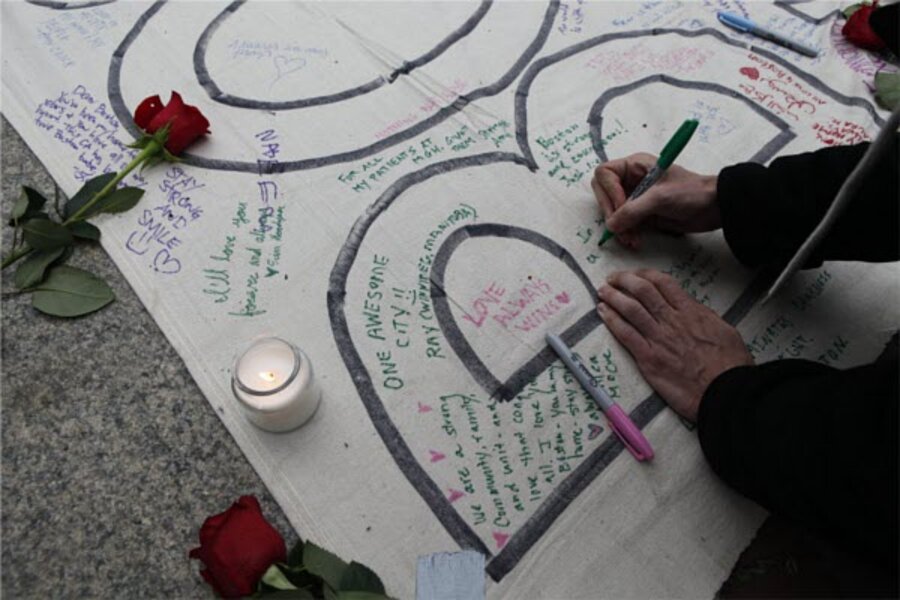Boston Marathon attack: Circle of possible bombers narrows, experts say
Loading...
| Boston
Details emerging from the Boston Marathon bombing so far suggest that the perpetrators are most likely to be identified as American jihadis or, possibly but less likely, antigovernment extremists, say counterterrorism experts.
Investigators have not offered any information about potential suspects and are still seeking tips and video from the public. Yet several experts who follow radical groups inside the US say the timing of the attack, the choice of weapon, the target, and the venue are all suggestive. Those things together are beginning to triangulate toward a small set of possible perpetrators, and, as is often the case, the weapon is key.
Two common pressure cookers packed with nails, ball bearings, and explosives were each rigged to a timer and used as a bomb, the FBI confirmed Tuesday. The two bombs exploded a block from each other 13 seconds apart at 2:50 p.m. – more than two hours after the winners of the marathon crossed the finish line.
The crude but effective bombs reinforce the views of several analysts who suggest that the blasts point to a lone-wolf-style attack. That could include one or two conspirators, but in any case would be an effort that is home grown and not the work of a tightly orchestrated, top-down directive from a central authority. These bombs could have been built by anyone with access to the Internet, motivation, and a place to test such a device in advance.
“We’ll know for sure when we get the forensic evidence on these pressure cookers,” says Alexia Ash, head of North America forecasting for IHS Exclusive Analysis Ltd., a specialist intelligence company. “But at this point what we are potentially talking about is really just one or two types of individuals or small groups – both are home-grown terrorists, either home-grown Islamic jihadists or right-wing extremists.”
The target – everyday Americans – may be instructive, too. The goal was mass casualties and a bloody spectacle in front of a big international television audience – a modus operandi consistent with past terrorist attempts by US-based right-wing and home-grown Islamic extremists, say Ms. Ash and other experts.
But the high-profile TV spectacle is more consistently a feature of jihadi aspirations – and on this point, experts who track both groups independently begin to discount the possibility that US right-wing extremists are behind the Boston attack.
“One thing that sticks out pretty quick is how these bombs were positioned so that those explosions would be in full view of the cameras,” says James J.F. Forest, director of the graduate program in security studies at the University of Massachusetts in Lowell. “They knew in advance which way the cameras would be pointing. International terrorists of the Al Qaeda variety definitely look for that, while we don’t see that among the right-wing domestic terrorists.”
Any number of things could have spurred a far-right antitax or antigovernment group or individual to attack the marathon. Such extremists could have seen an opportunity to highlight their opposition to the gun-control or immigration-reform bills emerging in Congress. Or symbolic timing might be a factor.
The Boston Marathon occurs on Patriots Day, a Massachusetts holiday that falls within a few days of other dates of symbolic importance to “Patriot movement” extremists in the US. Yet the date most important to the Patriot movement is April 19, in which two Southwestern cities were struck by tragedy – the fiery deaths of a radical religious group at Waco, Texas, in 1993, and the Oklahoma City bombing of 1995.
Timothy McVeigh knew the symbolism of the date he set for the Oklahoma City bombing, planning his attack on a federal office building to avenge the deaths he perceived to be at the hands of federal law officers in Waco two years earlier. Indeed, April 19 is such an important date for the far-right Patriot movement that the notion of trying to make a symbolic statement at the Boston Marathon a full three days earlier seems unlikely, several experts said.
“Just look at the targets – the targets don’t have anything in common other than they are Americans,” says Mark Potok of the Southern Poverty Law Center in Montgomery, Ala., an expert on domestic extremist groups. “This is not an attack aimed at government, or minority groups, or immigrants, or Muslims. When you look at the target of this attack, the only commonality is that they are Americans. There’s endless speculations about all these anniversaries, but while it’s certainly true that Patriots Day is an important, even iconic day for the Patriot movement’s extreme right, the day that is important to them is April 19, not the 15th.”
Others concur that the date may be an important clue, but say the lack of a government target makes it less likely that antigovernment extremists are behind the bombings.
“If it was not the Boston Marathon, all those dates would be highly suggestive as a motivation for a far-right group,” says J.M. Berger, an associate fellow with the International Centre for the Study of Radicalisation. “It doesn’t strike me as the type of thing the Patriot movement would endorse. They are generally antigovernment, so you would think about government targets. But sometimes an unbalanced individual may take action on their own.”
It's clear that attacks against the American public have precedent within the far-right extremist movement. Some analysts note similarities between the Boston bombings and the approach of anti-abortion radical Eric Rudolph, whose series of bomb attacks included the 1996 Olympics in Atlanta. Rudolph, a lone wolf, definitely did not confine himself to targeting government buildings.
But Mr. Potok and others aren’t buying it.
“People in the Patriot movement who have planned terror attacks have targeted the FBI, the IRS, civil rights groups, and the Southern Poverty Law Center –targets you can understand,” Potok says. “But domestic jihadists do fit the type who would do this. They’re not sophisticated, grew up in US. If you think how the unifying aspect is that the targets are all Americans and that the attack looks unsophisticated. We have to think about homegrown jihadists.”
Such views dovetail with an upswing in domestic jihadism and attempted jihadist attacks over the past decade, experts report. Between the Al Qaeda attacks of Sept. 11, 2001, and the end of 2009, 46 cases of domestic radicalization and recruitment to jihadist terrorism were reported in the United States, 13 of those in 2009, according to a 2010 RAND Corp. study.
“What is most at issue here are intentions, not ability,” writes terrorism expert Brian Jenkins in the RAND report. “The 46 cases demonstrate earnest intent. The individuals were ready to be terrorists. Their ideological commitment was manifest. Some were naïve, some were adventurers, some were misguided. But many were no doubt sincere in their anger and determination, having made the ideological leap to armed jihad. They came into contact with US authorities when they tried to act on their beliefs. They had, in the words of one prosecutor, 'jihadi hearts and jihadi minds,' and juries convicted them on their intent.”
Some experts say the trajectory of domestic jihadism has not lessened since that report, but seems to have grown. Again, experts are looking at the target and the weapon for clues.
A 2004 Department of Homeland Security Bulletin makes note of the international terrorist origins of a pressure-cooker-style bomb, used in September 2003 in India and in 2002 in Algeria and Nepal. An Al Qaeda publication outlines how to build one, and those instructions have been reproduced on the Internet. Knowledge of that weapon has spread, so that any would-be terrorist inside the US, whether a jihadi or a member of the antigovernment right, could use the blueprints.
But Al Qaeda operatives' preference for such tools tips the scale, some experts argue.
“The use of pressure cookers does make a difference, and I think it leans things more toward the Islamist side of the spectrum than that of the right-wing extremists,” Ash says.
Mr. Berger of the International Centre, however, warns that domestic jihadists often go their own way without respect to past precedent – and that investigators can be easily misled if they hew too strongly toward a past terrorism profile.
“The marathon is a soft target for an international terrorist,” he says. “It’s true the leaders of most terrorist movements now are advising their followers not to kill women and children. They don’t want their attacks to repulse the public; they want their attacks to win the public over. However, American activists who follow Al Qaeda often don’t follow the advice their leaders put out there for them.”
[Editor's note: An earlier version of this article mischaracterized Mr. Berger's final quote and incorrectly referred to him as a doctoral recipient.]








